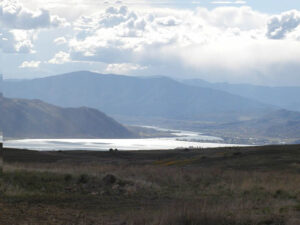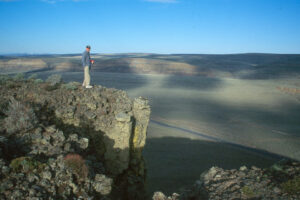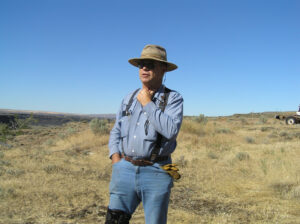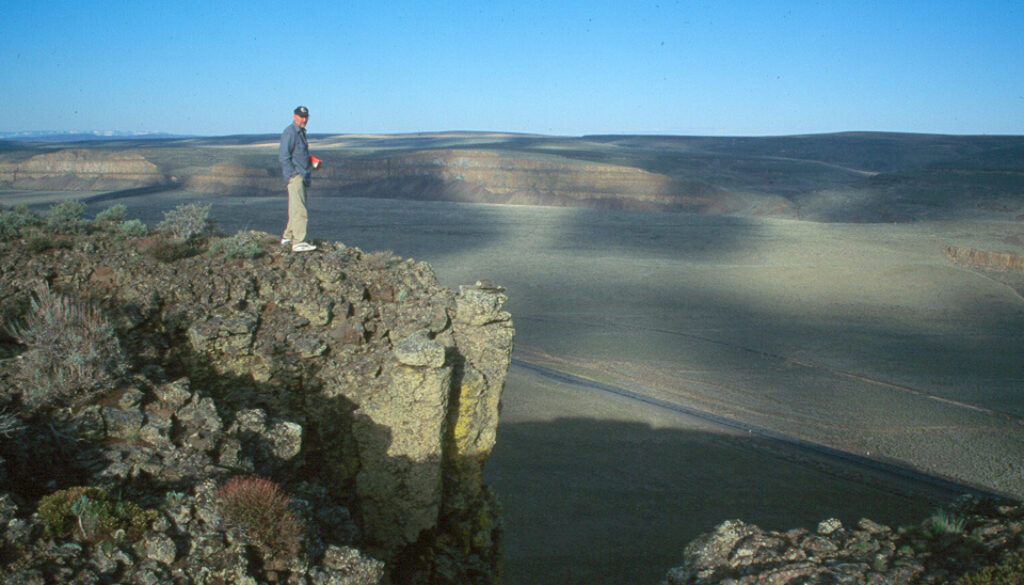Coming Into Place, Moses Coulee-Beezley Hills
Coming Into Place, Moses Coulee-Beezley Hills, Douglas and Grant counties
By Nancy Warner
Most of us who live in North Central Washington came from someplace else. Except for tribal members whose roots go back hundreds and hundreds of years, the rest of us either came from families who immigrated from other states and countries or we came here on our own, sometimes at the urging of friends.
 Regardless of when and how we arrived, most of us were drawn here by an enticing mix of opportunities, hopes, and dreams. In the late 1800s, it may have been the chance to homestead and own your own farm. By the 1930s it might have been the prospect of finding work in the orchards and building a better life for your family that spurred your move. More recent stories include those about people moving here from bigger cities to improve the quality of their daily lives – to enjoy a slower pace in beautiful space.
Regardless of when and how we arrived, most of us were drawn here by an enticing mix of opportunities, hopes, and dreams. In the late 1800s, it may have been the chance to homestead and own your own farm. By the 1930s it might have been the prospect of finding work in the orchards and building a better life for your family that spurred your move. More recent stories include those about people moving here from bigger cities to improve the quality of their daily lives – to enjoy a slower pace in beautiful space.
Collectively, when we immigrated here – from as far away as Germany or as close as Seattle – we brought values, traditions, knowledge, and skills that have helped shape this place. That’s something we all have in common. As immigrants, we’ve also all experienced the need to find help along the way – help in getting oriented to a new landscape and community, help starting a new job and making new friends – help making this place feel like home, a place where we belong.
For me, it was the chance to contribute to the conservation of the wide-open sagebrush country – or shrub-steppe – that prompted my family to move here from Colorado in 2000. My husband Chuck and I had been working as program managers for The Nature Conservancy since the 1980s, an international non-profit organization dedicated to conserving plants, animals and natural systems. We enjoyed the challenge of trying to balance conservation with farming, ranching, and the maintenance of strong, rural communities. We liked the process of really getting to know a place and the people and working with them to find ways to make nature and people thrive.
So we were excited to have the chance to start a new program for the Conservancy that would focus on working with other private and public landowners in the Moses Coulee-Beezley Hills area of Douglas and Grant counties. We were fired up about conserving the shrub lands, wildflowers, and wildlife that together represent the most ecologically diverse and threatened habitat type in Washington. To succeed we would have to understand the needs of the plants and animals – from pygmy rabbits to Indian tobacco – as well as those of neighboring farmers, ranchers, and public land managing agencies. We needed to be able to think like a whole community, human and non-human alike.
 As lifelong westerners, we quickly felt at ease in the landscapes here where residents with the deepest roots of all, such as sagebrush and ponderosa pine, were old friends we knew from other places. Their presence, along with that of many other familiar plants and animals quickly made us feel at home here. I still remember how thrilling and comforting it was to see sandhill cranes soaring above the cliffs of Moses Coulee that first spring we were here. Talk about indicators of a good place to live!
As lifelong westerners, we quickly felt at ease in the landscapes here where residents with the deepest roots of all, such as sagebrush and ponderosa pine, were old friends we knew from other places. Their presence, along with that of many other familiar plants and animals quickly made us feel at home here. I still remember how thrilling and comforting it was to see sandhill cranes soaring above the cliffs of Moses Coulee that first spring we were here. Talk about indicators of a good place to live!
But other things were new to us particularly basalt, the dark molten rock that dominates and defines the shrub steppe in the Columbia Basin. The significantly shorter winter and longer summer days of the Northwest also claimed our attention at first. And while I’ve always loved apples, we had never lived in a place where there were so many orchards – apricots, cherries, peaches, pears, and apples – presenting wave after wave of blooms through the spring. We had also known some pretty big rivers in other parts of the West, but nothing like the Columbia and the hydroelectric dams that still and channel its flow.
 So our eyes and ears were wide open as we began learning about the shrub-steppe and human communities of our new home. We spent a good deal of time in the field doing the typical start-up things for our line of work – exploring the landscape and helping with field surveys as well as reading reports, attending meetings, and developing the network of contacts that could help us frame effective land management and restoration decisions.
So our eyes and ears were wide open as we began learning about the shrub-steppe and human communities of our new home. We spent a good deal of time in the field doing the typical start-up things for our line of work – exploring the landscape and helping with field surveys as well as reading reports, attending meetings, and developing the network of contacts that could help us frame effective land management and restoration decisions.
While we had a great circle of researchers and land managers to work with, many of them having had years of experience in this landscape, it quickly became clear that we needed more information about past human use of the Moses Coulee-Beezley Hills area to effectively think like a community and consider the roles of grazing, hunting, farming, traditional gathering, and wetland and upland restoration in the management of the Conservancy’s lands. As it turned out, many of our neighbors and longtime residents were willing to help us fill in some of those information gaps by allowing us to record their stories.
This practice of gathering oral histories, ground-tested knowledge earned by the people who had lived in a place for a long time, was one of the interests and skills I brought with me to this region. I’d reached out to local residents for help in better understanding a landscape before, gathering oral histories in other places we’d lived including Cache Valley in Utah, the Carrizo Plain in California and the San Luis Valley in Colorado. In all of these places I’d found people anxious to help me get my bearings in a new home – to help me understand how a given landscape or community works by sharing their memories and insights – their experiences, what they’ve seen and learned over the years, and what they appreciate about their place.
 People also shared photographs, documents, equipment and other things along with their stories. In the process they helped me feel more welcome and at home – helped me populate an unfamiliar landscape with meaningful stories that I could build upon over time. And, without the formal structure of a service club, these interviewees and neighbors also helped me expand my network by recommending and introducing me to other people who could help me broaden and deepen my education about this place.
People also shared photographs, documents, equipment and other things along with their stories. In the process they helped me feel more welcome and at home – helped me populate an unfamiliar landscape with meaningful stories that I could build upon over time. And, without the formal structure of a service club, these interviewees and neighbors also helped me expand my network by recommending and introducing me to other people who could help me broaden and deepen my education about this place.
Recognizing the value of these stories and the process of gathering them, I began to work with a new organization, the Initiative for Rural Innovation & Stewardship (IRIS) to expand this practice starting in 2005. Since then, I’ve been working with IRIS and many partners to gather, share, and care for nearly 600 stories about successes in this region in formats that range from audio recordings and videos to photo collections and printed publications. See www.ncwcollections.org
Those of us with IRIS believe that the process of gathering and sharing success stories enhances a sense of belonging, inspires action and builds community – all conditions that lead to success. Together this collection of stories helps us learn more about the nature of this place – the natural landscape and the human community, informs actions about what works, and highlights core values that continue to shape the way we live in this place. We hope you enjoy sampling these stories. We invite you to share them with others and to add your own story of success that can help others come into this place.

